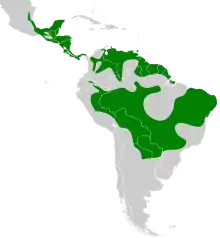Barred antshrike
The barred antshrike (Thamnophilus doliatus) is a passerine bird in the antbird family. It is found in the Neotropics from Tamaulipas, Mexico, through Central America, Trinidad and Tobago, and a large part of South America east of the Andes as far south as northern Argentina, Bolivia and Paraguay. There is one accepted record from southern Texas.[2] It is found in a wide range of wooded habitats (even gardens and parks) in both humid and arid regions. Throughout a large part of its range, it is among the most common antbirds.
| Barred antshrike | |
|---|---|
 | |
| Male in Goiás, Brazil | |
| Duet of pair from Carara National Park, Costa Rica | |
| Scientific classification | |
| Kingdom: | Animalia |
| Phylum: | Chordata |
| Class: | Aves |
| Order: | Passeriformes |
| Family: | Thamnophilidae |
| Genus: | Thamnophilus |
| Species: | T. doliatus |
| Binomial name | |
| Thamnophilus doliatus (Linnaeus, 1764) | |
 | |
| Synonyms | |
|
Lanius doliatus Linnaeus, 1764 | |
Taxonomy
The barred antshrike was described by the Swedish naturalist Carl Linnaeus in 1764 and given the binomial name Lanius doliatus.[3] The type locality was subsequently designated as Surinam.[4] The specific epithet is from New Latin doliatus meaning "barred".[5] There are 12 recognised subspecies.[6]
Description
The barred antshrike is 15–16 cm (5.9–6.3 in) in length, and weighs 24–30 g (0.85–1.06 oz). This species exhibits marked sexual dimorphism. The male of the nominate race is barred all over with black and white, and has a white-based black crest that is raised in display. The female is rufous above with a chestnut crest. The sides of her head and neck are streaked with black, and the underparts are rich buff. In both sexes, the legs are grey, the bill is black and the iris is pale yellow.[7]
The subspecies vary primarily in the overall darkness and the amount of barring and hue of the underparts. For example, in the Tobagonian race T. d. tobagensis, males are whiter below, and females darker, than in the nominate subspecies. The most distinctive subspecies is T. d. capistratus of the Caatinga in north-eastern Brazil, where males have uniform black crown (no white barring to the base) and females have streaked throat and faintly barred belly. It is also the only subspecies where the iris is deep maroon-red. It has been suggested that it should be considered a separate species, the Caatinga barred antshrike.[8]
Behavior
It is typically found as territorial pairs. The female lays two purple-marked creamy white eggs in a deep cup nest in a shrub, which are incubated by both sexes for 14 days to hatching. The chicks fledge in another 12–13 days.
The barred antshrike is an insectivore which feeds on ants and other arthropods at or near the ground; it sometimes follows columns of army ants, and will take small lizards and berries. It is a skulking species, which may be located by its chuckling hu-hu-hu-hu-hu-hu song, often performed as a duet by a pair of birds, or a growled graaaaa.
Gallery

 Female, Brazil
Female, Brazil Male in Panama
Male in Panama_male_To.jpg.webp) Male T. d. tobagensis, Tobago
Male T. d. tobagensis, Tobago_female.jpg.webp) Female T. d. tobagensis, Tobago
Female T. d. tobagensis, Tobago.jpg.webp) Male, Henri Pittier National Park, Venezuela
Male, Henri Pittier National Park, Venezuela
References
- BirdLife International (2012). "Thamnophilus doliatus". IUCN Red List of Threatened Species. 2012. Retrieved 26 November 2013.CS1 maint: ref=harv (link)
- Lockwood, Mark W. (December 2007). "Texas Bird Records Committee Report for 2007". texasbirds.org. The Texas Bird Records Committee. Archived from the original on 2009-12-08.
- Linnaeus, Carl (1764). Museum S:ae R:ae M:tis Adolphi Friderici Regis (in Latin). Volume 2. Holmiae (Stockholm): Salvius. p. 12.
- Peters, James Lee, ed. (1951). Check-list of Birds of the World. Volume 7. Cambridge, Massachusetts: Museum of Comparative Zoology. p. 165.
- Jobling, James A. (2010). The Helm Dictionary of Scientific Bird Names. London: Christopher Helm. p. 138. ISBN 978-1-4081-2501-4.
- Gill, Frank; Donsker, David, eds. (2018). "Antbirds". World Bird List Version 8.1. International Ornithologists' Union. Retrieved 11 March 2018.
- Zimmer, K.; Isler, M.L.; Christie, D.A. (2018). del Hoyo, J.; Elliott, A.; Sargatal, J.; Christie, D.A.; de Juana, E. (eds.). "Barred Antshrike (Thamnophilus doliatus)". Handbook of the Birds of the World Alive. Lynx Edicions. Retrieved 14 March 2018.
- Assis, C.P.; Raposo, M.A.; Stopiglia, R.; Parrini, R. (2007). "Validation of Thamnophilus capistratus Lesson, 1840 (Passeriformes, Thamnophilidae)". Auk. 124 (2): 665–676. doi:10.1642/0004-8038(2007)124[665:VOTCLP]2.0.CO;2.
Further reading
- Skutch, Alexander F. (1969). "Barred antshrike" (PDF). Life Histories of Central American Birds III: Families Cotingidae, Pipridae, Formicariidae, Furnariidae, Dendrocolaptidae, and Picidae. Pacific Coast Avifauna, Number 35. Berkeley, California: Cooper Ornithological Society. pp. 191–196.
External links
| Wikimedia Commons has media related to Thamnophilus doliatus. |
| Wikispecies has information related to Thamnophilus doliatus. |
- Barred antshike images at www.surinamebirds.nl
- "Barred antshrike media". Internet Bird Collection.
- Barred antshrike photo gallery at VIREO (Drexel University)
- Barred antshrike species account at Neotropical Birds (Cornell Lab of Ornithology)
- Interactive range map of Thamnophilus doliatus at IUCN Red List maps
- Audio recordings of Barred antshrike on Xeno-canto.
